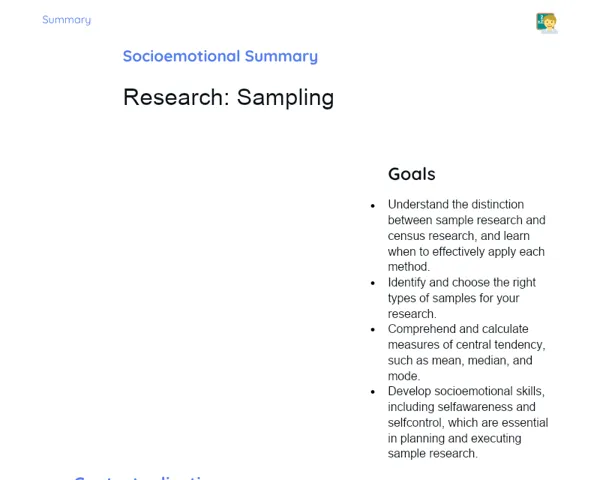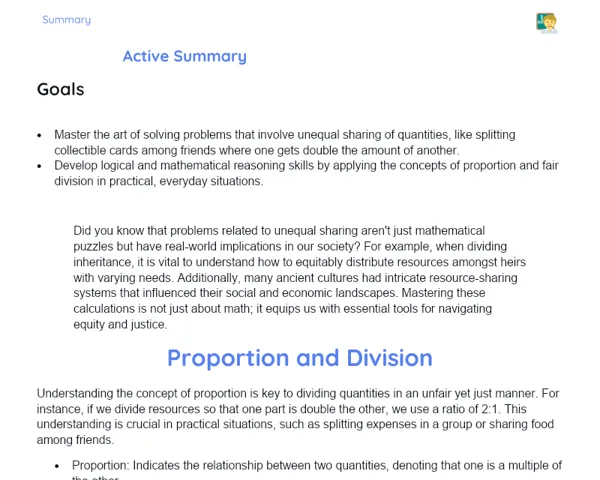Summary Tradisional | Analytic Geometry: Equation of a Line
Contextualization
Analytical Geometry, also known as coordinate geometry, merges concepts from algebra and geometry to visually solve problems. One of the cornerstones of this subject is the equation of a line, which portrays the location and slope of lines on the Cartesian plane. Grasping the equation of a line is crucial for practical applications across fields like physics, engineering, and economics, where visual data representation and analysis often come into play.
The equation of a line is generally expressed as ax + by + c = 0, where a, b, and c are real coefficients. This format is vital for representing lines on a Cartesian plane and helps in identifying key characteristics such as slope and intersection points with the axes. Furthermore, a solid understanding of this equation is essential for trend analysis in graphs, applicable in both academic settings and professional domains, making it an invaluable tool in many fields.
To Remember!
Definition of the General Equation of a Line
The general form of the line's equation is given by ax + by + c = 0, where a, b, and c are real coefficients. This representation is fundamental in Analytical Geometry as it allows for the depiction of any line on the Cartesian plane. It’s important to note that both a and b cannot be zero at the same time; otherwise, it doesn’t represent a line.
If a ≠ 0 and b = 0, we have a vertical line (where x remains constant). Conversely, if a = 0 and b ≠ 0, this indicates a horizontal line (where y is constant). In all other scenarios, the line is oblique.
Mastering the general form of the line's equation is crucial for algebraic tasks such as transforming it into other formats and for understanding its geometric properties on the Cartesian plane.
-
General form: ax + by + c = 0.
-
Coefficients a, b, and c are real numbers.
-
a and b cannot both be zero.
Identifying the Coefficients
In the general equation of a line, the coefficients a, b, and c can be identified directly. For instance, in the equation 2x - 3y + 6 = 0, we have a = 2, b = -3, and c = 6. Recognizing these coefficients accurately is essential for any manipulation or understanding of the line's equation.
The coefficient a corresponds to the x term and helps determine the line's slope, while b relates to the y term (influencing the vertical slope). The constant c determines the line's position on the Cartesian plane.
Identifying these coefficients correctly paves the way to transforming the general equation into different forms, such as the slope-intercept form, making graphical analysis easier.
-
Direct identification of coefficients a, b, and c.
-
a corresponds to the x term, b corresponds to the y term, and c is the constant term.
-
Accurate identification is essential for manipulations and interpretations.
Graphical Interpretation
On the Cartesian plane, the equation of a line can be graphically interpreted, where every point (x, y) that satisfies the equation resides on the line. The slope, represented by the coefficient m, is calculated as -a/b when b ≠ 0. This slope indicates the line's direction and inclination.
The point where the line intersects the y-axis can be determined by substituting x = 0 into the equation, leading to y = -c/b. This point is essential for plotting the line, serving as a visual reference on the graph.
Understanding the graphical representation of the line's equation is instrumental in visualizing geometric problems and analyzing linear relationships in subjects such as physics and economics.
-
Every point (x, y) that satisfies the equation lies on the line.
-
The slope m is calculated as -a/b.
-
The y-intercept is found by determining y at x = 0.
Slope-Intercept Form of the Equation of a Line
The slope-intercept form of the equation of a line is articulated as y = mx + n, where m is the slope and n is the y-intercept, indicating where the line crosses the y-axis. This form is particularly useful for graphical representation, simplifying the understanding of the slope and intercept point.
To transition the general equation ax + by + c = 0 to slope-intercept form, isolating y is necessary. For example, with the equation 3x + 4y - 12 = 0, we isolate y: 4y = -3x + 12, yielding y = -3/4x + 3.
The slope-intercept format is widely utilized in various domains, including linear regression analysis in statistics, where relationships between variables are modeled and visually interpreted.
-
Slope-intercept form: y = mx + n.
-
m is the slope and n is the y-intercept.
-
Transforming from general to slope-intercept form requires isolating y.
Converting Between Forms
The ability to convert between the general equation and the slope-intercept form of a line is a vital skill in Analytical Geometry. Changing from general form ax + by + c = 0 to slope-intercept form y = mx + n entails isolating y. For instance, in the equation 4x + 3y - 12 = 0, we isolate y: 3y = -4x + 12, resulting in y = -4/3x + 4.
Conversely, transforming from slope-intercept back to general form requires algebraic rearrangements to eliminate fractions. For example, the equation y = 2x + 3 can be changed to general form by subtracting 2x and 3 from both sides, yielding 2x - y + 3 = 0.
Being adept at converting between these forms allows for greater flexibility in problem analysis and provides an effective way to communicate mathematical ideas with clarity.
-
Transforming from general to slope-intercept form includes isolating y.
-
Going back from slope-intercept to general form involves rearranging the terms.
-
Provides flexibility in analysis and problem-solving.
Key Terms
-
Analytical Geometry: A branch of mathematics that integrates algebra with geometry.
-
Equation of a Line: A mathematical expression that depicts a straight line on the Cartesian plane.
-
Coefficients: The values a, b, and c in the general line equation ax + by + c = 0.
-
Slope: The ratio -a/b that indicates the line's direction.
-
Intersection: The point where the line crosses the Cartesian axes.
-
General Form: The equation of the line given by ax + by + c = 0.
-
Slope-Intercept Form: The equation of the line expressed as y = mx + n.
-
Cartesian Plane: A plane defined by two perpendicular axes, x and y.
Important Conclusions
In this lesson, we delved into the equation of a line within Analytical Geometry, focusing on its general form ax + by + c = 0 and how to identify the coefficients a, b, and c. We recognized the significance of these coefficients in determining the line's slope and intersection points on the Cartesian plane. Furthermore, we explored converting the equation from general form to slope-intercept form y = mx + n, aiding graphical interpretation.
The graphical interpretation of the equation is vital for visualizing geometric problems and analyzing data. The slope, defined by -a/b, and the point of intersection on the y-axis are key elements for understanding the behavior of lines. The capability to switch between general and slope-intercept forms adds versatility to analysis and problem-solving.
The equation of a line is a robust tool utilized across various fields like physics, engineering, and economics. Grasping and applying these concepts is fundamental for cultivating advanced math skills and addressing real-world issues. We encourage students to further explore the topic and practice manipulating equations to reinforce their understanding.
Study Tips
-
Go through the practical examples we tackled in class and try solving additional problems to enhance your understanding of the concepts.
-
Utilize online resources like educational videos and interactive exercises to visualize how the equation of a line works.
-
Form study groups with classmates to discuss and work on problems related to the equation of a line, sharing various approaches and solutions.



